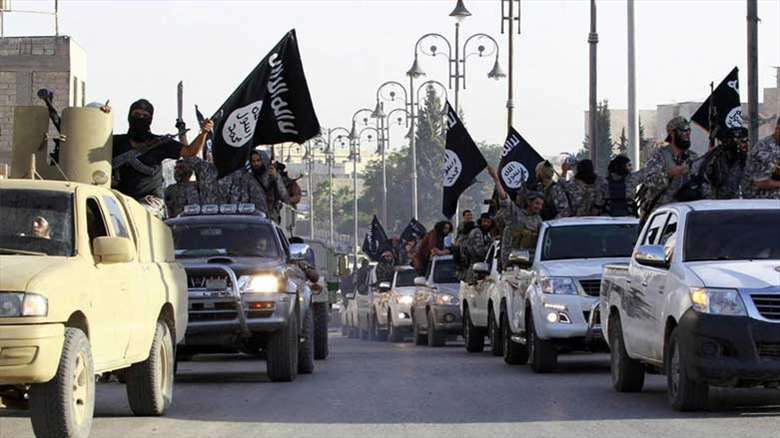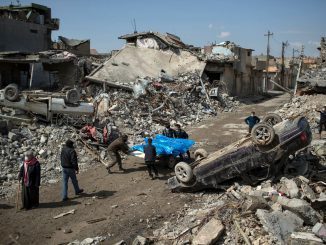
US-backed fighters in Syria have accused the Islamic State (ISIS) group of taking more than 2,000 people hostage, and using them as human shields, as they retreated from the northern city of Manbij.
The Syrian Democratic Forces (SDF), a US-backed alliance consisting primarily of Kurdish fighters, said on Friday they were in control of most of the city, held by ISIS, also known as ISIS, since 2014.
SDF spokesperson Sharfan Darwish said in a statement released on Facebook that rebel fighters had “regained control over most of the city” while “clashes in several areas” continued as clearing operations were underway to flush out the last ISIS remnants.
“While withdrawing from a district of Manbij, ISIS members abducted around 2,000 civilians from Al-Sirb neighborhood,” Darwish told the AFP news agency.
“They used these civilians as human shields as they withdrew to Jarabulus, thus preventing us from targeting them,” he said, adding that women and children were among those taken.
Darwish later told the Reuters news agency that the SDF had freed more than 2,000 civilian hostages held by ISIS.
The UK-based Syrian Observatory for Human Rights (SOHR) said on Friday that around 500 cars had left Manbij carrying ISIS members and civilians, heading northeast towards Jarablus, a town under the control of the armed group on the Turkish border.
“There are reports that perhaps there was an agreement between the SDF and ISIS, allowing them to leave without any attacks,” a journalist said.
“There are also more troubling reports that as they were leaving, ISIS took with them civilians, using them as human shields” so as not to be attacked.
“That is perhaps an explanation of why there was no fighting as ISIS fighters and their supporters left,” Sayah said.
Manbij has been the main front in a US-led anti-ISIS coalition ground war for months.
The SDF and coalition forces launched an operation on May 31 and slowly advanced into the city.
The group said last week they had taken 90 percent of Manbij from ISIL.
Friday’s advance was the “last operation and the last assault” to retake the city, SDF spokesperson Darwish told the Reuters news agency.
Syria Democratic Forces (SDF), an alliance of mainly Kurdish fighters backed by the US, launched an offensive against ISIS to retake the city of Manbij in May. Kurdish militias aim at controlling Manbij to complete their control over northern Syria and pave the way to their autonomy goal.
They have besieged the town and are advancing to the city center under the cover of air strikes by the US-led international coalition.
The Kurdish militias also used the US support to attack many Arab villages, commit massacres there and force the citizens to flee.
Kurdish militias or ISIS ?
If successful, Manbij taking over could cut the militants’ main access route to the outside world, paving the way for an assault on their Syrian capital Raqqa. However, the Kurdish militias have bigger plans for the area as they seek their autonomy.
The autonomous federation being planned by Syrian Kurdish parties and their allies is taking shape fast: a constitution should be finalized in three months, and possibly sooner, to be followed quickly by-elections, a Kurdish official said.
The political federation for northern Syria builds on three self-ruled regions carved out by the YPG since Syria descended into conflict in 2011 in an uprising to topple President Bashar al-Assad. It has already grown, expanding last year to include the town of Tel Abyad that was captured from Islamic State by the YPG in October.
In fact, Kurdish militias use US support to launch offensives against new areas under the term of fighting ISIS, while the force the Arab citizens to flee their homes, so the Kurdish militias can force control over new areas and add it to their contents.
They are accused of making ethnic crimes against Arab citizens in northern Syria.
Syrian Kurdish groups have made no secret of their aim to link up their two autonomous regions, or cantons, in northeastern Syria with one further west – Afrin. All that’s preventing them is the 80 km stretch of territory at the Turkish border held by IS near Manbij and further west by Turkey-backed rebel groups that are hostile to the YPG.
The plan had taken on even greater significance since the Syria Democratic Forces alliance, which is spearheaded by the Kurdish YPG militia, mounted a rapid new advance westwards this month into Islamic State’s last foothold at the Turkish border.



